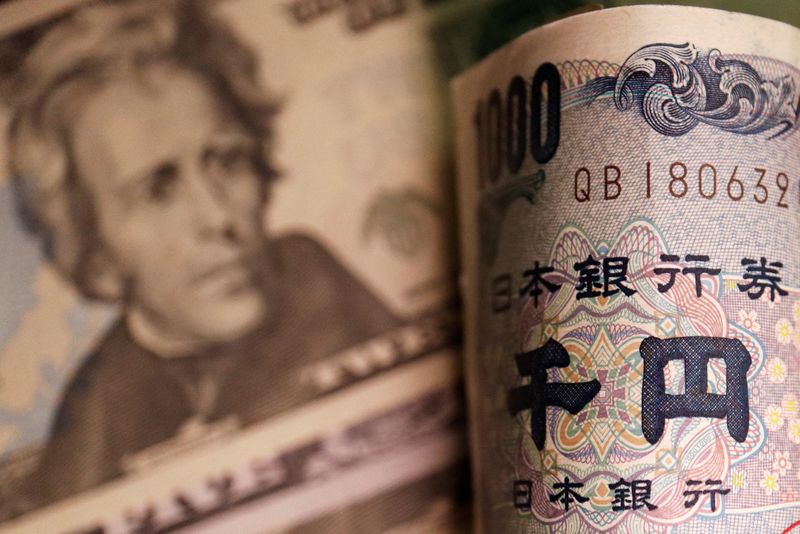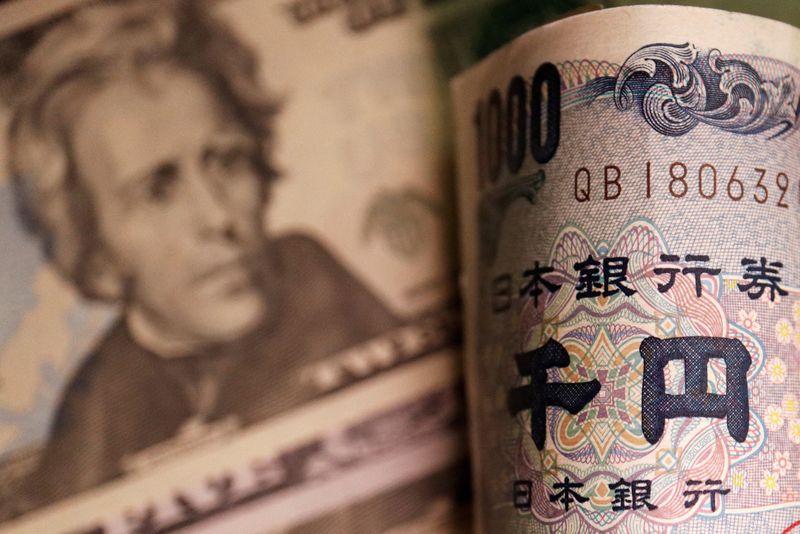Forex
Euro, sterling drop on weak PMIs, dollar hits 2-month high


© Reuters. FILE PHOTO: Banknotes of Japanese yen and U.S. dollar are seen in this illustration picture taken September 23, 2022. REUTERS/Florence Lo/Illustration
By Samuel Indyk and Ankur Banerjee
LONDON (Reuters) – Gloomy business activity data from the euro area and Britain sent the euro and pound tumbling against the dollar on Wednesday, pushing the greenback to its highest level in two months.
HCOB’s flash Composite Purchasing Managers’ Index (PMI) for the euro area, compiled by S&P Global (NYSE:), dropped to 47.0 in August from July’s 48.6, its lowest since November 2020. The services component sank to 48.3 from 50.9, its first time below the 50 mark that separates growth from contraction this year.
The German composite figure fell to its lowest since May 2020 as a deepening downturn in manufacturing output was accompanied by a renewed contraction in services activity.
The single currency weakened after the German data, hitting its lowest level against the dollar since June 15 at $1.0805.
“The decline in services activity was a sharp move and we’ve seen a soft euro environment,” said Niels Christensen, chief analyst at Nordea.
“If inflation data continues to slow then the European Central Bank might pause their tightening cycle in September.”
It was a similar picture for the pound, which fell to its lowest level in over a week at $1.2623, after the S&P Global/CIPS PMI tumbled to 47.9 in August, the lowest level since January 2021, while the survey also showed price and cost pressures eased.
“This combination … should give the Bank of England food for thought in advance of its next interest rate decision in September and suggests an increase is no longer a certainty.” said Martin Beck, chief economic advisor to the EY ITEM Club.
The dollar rose to a two-month peak after the data, with investors looking to Federal Reserve chair Jerome Powell’s speech this week at the Jackson Hole Symposium for cues on the monetary policy path.
The , which measures the U.S. currency against six rivals and is most heavily weighted to the euro, rose to 103.95, its highest level since June 8. The index is up 2% in August, on course to snap a two-month losing streak.
A recent run of strong U.S. economic data has helped allay worries of an impending recession but with inflation still above the Fed’s target of 2%, investors are wary that the central bank may keep rates in a higher range for longer.
“There’s no reason for Powell to close the door for more rate hikes or make a firm promise to hike more,” Nordea’s Christensen said.
“The U.S. economy is slowing a bit but is holding up much better than Europe and that could give the dollar the upper hand.”
Markets are pricing in around an 85% chance of the Fed standing pat at its policy meeting next month, but the odds of the U.S. central bank hiking interest rates one more time this year toward the end of the year have been rising slightly.
Meanwhile, the yen strengthened 0.4% to 145.30 per dollar but was not far off the nine-month milestone of 146.565 touched last week, leaving traders on tenterhooks as they warily watch for any signs of intervention.
The dollar’s break above 145 yen last year triggered intervention, and speculation has begun mounting that Tokyo could soon step into the market to support its currency again if the yen weakens further.
“Despite the proximity to last autumn’s FX intervention level, we see the prospect of intervention below 150 as unlikely and believe that the pair needs to go closer to 155 before MoF (Japan’s Ministry of Finance) considers pulling the trigger,” said Colin Asher, senior economist at Mizuho.
Another Asian currency that has worried investors is , which is down over 5% this year against the dollar largely due to concerns over the country’s deepening property crisis, which is putting further downward pressure on China’s sputtering post-pandemic economic recovery.
The spot yuan opened at 7.2870 per dollar on Wednesday and was last changing hands at 7.2899.

 Forex3 years ago
Forex3 years agoForex Today: the dollar is gaining strength amid gloomy sentiment at the start of the Fed’s week

 Forex3 years ago
Forex3 years agoUnbiased review of Pocket Option broker

 Forex3 years ago
Forex3 years agoDollar to pound sterling exchange rate today: Pound plummeted to its lowest since 1985

 Forex3 years ago
Forex3 years agoHow is the Australian dollar doing today?

 Cryptocurrency3 years ago
Cryptocurrency3 years agoWhat happened in the crypto market – current events today

 World3 years ago
World3 years agoWhy are modern video games an art form?

 Commodities3 years ago
Commodities3 years agoCopper continues to fall in price on expectations of lower demand in China

 Economy3 years ago
Economy3 years agoCrude oil tankers double in price due to EU anti-Russian sanctions























